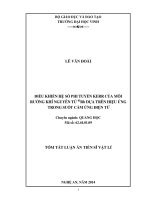Section 1 3 TRƯỜNG ĐIỆN TỪ
Bạn đang xem bản rút gọn của tài liệu. Xem và tải ngay bản đầy đủ của tài liệu tại đây (93.09 KB, 12 trang )
Slide Presentations for ECE 329,
Introduction to Electromagnetic Fields,
to supplement “Elements of Engineering
Electromagnetics, Sixth Edition”
by
Nannapaneni Narayana Rao
Edward C. Jordan Professor of Electrical and Computer Engineering
University of Illinois at Urbana-Champaign, Urbana, Illinois, USA
Distinguished Amrita Professor of Engineering
Amrita Vishwa Vidyapeetham, Coimbatore, Tamil Nadu, India
1.3
Cylindrical and Spherical
Coordinate Systems
1.3-3
Cylindrical and Spherical Coordinate Systems
Cylindrical (r, , z)
z
Spherical (r, , )
z
az
a
90Þ
x
x r
y
z
ar
a
r
ar
y
x
Only az is uniform.
All three unit
ar and a are
nonuniform.
vectors are
nonuniform.
90Þ
a
y
1.3-4
= r cos
= r sin
=z
x
y
z
D1.7 (a)
x = r sin cos
y = r sin sin
z = r cos
(2, 5/6, 3) in cylindrical coordinates
z
3
2
x
5/6
y
x 2 cos 5 6 – 3
3 1 2
y 2 sin 5 61
z 3
1.3-5
(b) (4, 4 3, – 1) in cylindrical coordinates
z
1
4
4/3
y
x
x 4 cos 4 3 – 2
4 12 4
y 4 sin 4 3 – 2 3
z – 1
1.3-6
(c) (4, 2 3, 6) in spherical coordinates
z
2/3
x
y
/6
4
2
x 4 sin
cos 3
3
6
2
y 4 sin
sin 3 9 3 4 4
3
6
z 4 cos – 2
3
(d)
1.3-7
8, 4, 3 in spherical coordinates.
z
/4
x
/3
8
y
x 8 sin cos 1
4
3
y 8 sin sin 3 1 3 4 8
4
3
z 8 cos 2
4
1.3-8
Conversion of vectors between coordinate systems
a rc cos sin 0 a x
a
a
–sin
cos
0
y
0
1
0
a z
a z
a rs sin cos sin sin
a cos cos cos sin
cos
a
– sin
a
az
ay
ax arc
a
az
ars
arc
a
cos a x
– sin a y
0 a z
1.3-9
P1.18
A
= ar at (2, /6, 2)
B
= a at (1, /3, 0)
C
= i at (3, /4, 3/2)
A
z
/6
x
/2
y
A sin a y cos a z
6
6
1
3
ay
az
2
2
1 3
1
4 4
1.3-10
z
3
1
y
B
x
1 3
1
4 4
z
C
3
/4
3/2
x
B sin a x – cos a z
6
6
1
3
ax –
az
2
2
y
C a x
1.3-11
1
1
3
3
(a) A B a y
az ax
az
2
2 2
2
3
4
1
3
(b) A C a y
az ax
2
2
0
1.3-12
1
3
(c) B C ax
a
a
z
x
2
2
1
2
(d) A B • C C • A B
1
= 0
1
2
–
0
1
2
0
3
2
3
0 –
2
3
4









